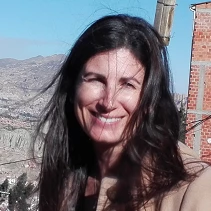

Why use satellite images? And what for? The limited availability of data, a limited budget, and tight schedule prompted the team to use satellite images to study the composition of urban land in Trinidad. The idea was to understand not only to what extent the city had grown in recent years, but go a step further and understand how this growth took place (e.g. its shape and nature of this growth). Through interviews with local and national authorities, we anecdotally knew that the city had expanded its urban spot considerably. But what kind of land uses had driven this growth? Was it an orderly residential growth or, on the contrary, an organic and uncoordinated expansion? We suspected that reality corresponded to the latter, but we wanted to prove it with solid evidence.
How does the methodology work? As in a photograph, each pixel contains valuable information (e.g. color, shape, reflection) which allows inferring characteristics of the physical structures in the image captured using a computerized algorithm. For example, taking parameters such as the number and density of right angles we can infer the positioning of road lines. Likewise, the color, luminosity, shape and size of certain structures allow inferring the existence of residential or commercial areas. These areas tend to have larger ceilings and have paved roads in their vicinity, while the roofs of slum dwellings are noticeably smaller and built structures are not organized necessarily in a grid (with intersections crossing at right angles). To learn more about this methodology, visit our previous blog, where we describe in detail the application of this land classifying algorithm in several cities across Latin America, including Trinidad.
What did we learn?
- 40% of the urban land in Trinidad is covered by slums, mostly located in the urban periphery: through a comparative analysis using images from 2007 and 2015, we know that urban sprawl has been driven mostly by the emergence of new slums. In 2007, these settlements occupied almost a third of urban land (299 square kilometers), while in 2015 they came to occupy 40% (544 square kilometers) of the city’s land. The city’s total area itself has also grown substantially, with urban footprint expanding by 38.97% during the 2007-2015 period (4.87% per annum). In addition to its rapid growth, these settlements are located predominantly in the urban periphery, adding to the already pressing demand for public services and new infrastructure investments.
- A large proportion of these settlements has grown in areas vulnerable to flooding: the use of satellite images also allows us to identify risk areas within a city. With this information, we identified that the expansion of informal settlements (or areas with low-quality housing for a better name) has been more pronounced in the outskirts of the city, especially towards the lowlands located southwest of the city center that are most vulnerable to the risk of flooding. http://wrld.bg/lK9230hiCxn

Do you want to try this methodology in your city? Here is what you need:
- High resolution images (a minimum resolution of at least 2 meters suggested).
- Memory space (1TB of recommended space).
- A desktop computer or a laptop with enough processing capacity (at least 8GB RAM).
- Download and install Python 2.7 (data processing software, available free).
- Download open source algorithm to classify images: https://jgrss.github.io/spfeas/ (to download for free, please register and request access to the GitHub user “jgrss”).
- Budget 1-2 weeks of qualified staff for data processing and analysis.
To read the full report, download the Technical Assistance Report “Intermediate Cities in Bolivia” and the Trinidad Case Study (in Spanish). An Executive Summary is also available in English and Spanish.
To download the data derived from satellite imagery, visit https://datacatalog.worldbank.org/
Questions? Please write to Ana I. Aguilera ( aaguileradellano@worldbank.org), Zoe Trohanis ( ztrohanis@worldbank.org) or Sarah E. Antos ( santos@worldbank.org).




Join the Conversation